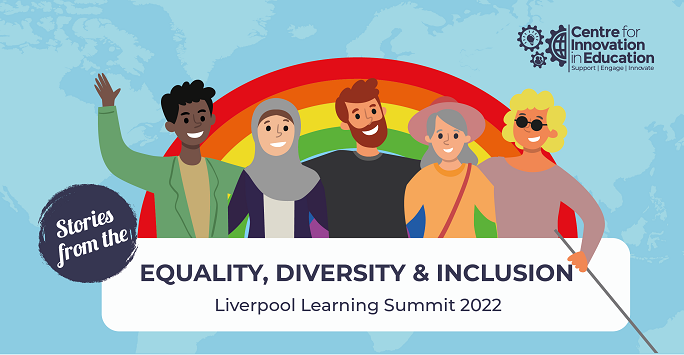Dispelling Deficit Myths...
Posted on: 11 February 2022 by Ceridwen Coulby in Conference & Event Reports

As part of the Centre for Innovation in Education’s annual Liverpool Learning Summit in January 2022 I was fortunate enough to attend a wonderful talk by Dr Gemma Ahearne, Lecturer in Criminology at the University of Liverpool, 'entitled Down the Rabbit Hole: Non-Linear Pedagogy from a Dyslexic Teacher’.
I’m not going to start this blogpost by saying how brave Gemma is for talking about her experiences of being a dyslexic child, PhD student and lecturer; partially because it goes without saying, but mainly because it frames those with dyslexia as victims or deficient in some way. When you meet Gemma, you see that is so far from the truth it is laughable.
Interestingly Gemma was not diagnosed with dyslexia until 2020, when already an educator herself. Having spent a childhood recognisable to many dyslexics where teachers bemoaned her ‘laziness’ telling her she was bright and should ‘try harder’, you might imagine that getting a diagnosis would be a relief. Whilst Gemma said the diagnosis gave her confidence (that she was certainly not lazy!) her over-riding experience was ‘overwhelming’.
She was bombarded with information about dyslexia from all sides. A common misconception people have of dyslexics according to Gemma is that it is all about having trouble reading and writing. From her own perspective Gemma finds processing information a lot more difficult than either of these activities. She also has problems with her short-term memory which she compensates for by preparing well in advance for meetings and classes, making a great deal of notes.
Gemma describes dyslexia as a super power. Dyslexic brains work differently, and she describes being able to hold competing and conflicting thoughts, create nuanced arguments and recognise patterns that emerge in data or discourse. She describes dyslexics as creative and innovative, great problem-solvers and visual thinkers, and points out that “all these traits are the skills of the future”. She portrayed her brain as a computer with 30-40 tabs open at all times that she can connect together in many different ways. Useful traits indeed.
Dyslexia is a super-power
- We can hold competing and conflicting thoughts and create nuanced arguments and recognise patterns that emerge in data or discourse (my recent work on Covid which is multi-disciplinary evidences this).
- We are creative and innovative- we like inventing
- We are great problem-solvers
- We are visual thinkers
- All these traits are the skills of the future.
Due to her own experiences of learning, Gemma designs her modules differently, in a way that supports dyslexic students but also benefits the whole student population. For example, in her third year module ‘Crime, Justice and the Sex Industry’ she ensures all content is pre-loaded before the start of the module and is accessible through a visual map on one page within the VLE. This means that students can see the whole module at once and prepare as necessary.
She also does not force students to complete module content in a chronological order. Students may work through the content of the module as they please, meaning that weekly tutorials have students with many different perspectives present, and cross fertilisation of ideas is the norm. She uses a wide variety of resources in her modules: blogs, videos, Instagram feeds etc. as well as more traditional academic sources such as books and journal articles, because it’s all about giving students different ways in to access the content and spark an interest. She uses guided walks as a way of embodying learning experiences and challenging stereotypes. Her students love her approach, and demand for the module is high.
By using her own lived experience of dyslexia in her module design and teaching methods Gemma has managed not only to accommodate dyslexic students in her pedagogy, but also make teaching and learning more accessible, interesting and engaging for all her students. Proof that inclusive design benefits everyone.
If you’d like to find out more about Gemma’s work, take a look at the case study she has shared on Non-Linear Micro-Learning.
Keywords: Liverpool Learning Summit, Summit, Liverpool, EDI, Super Power.